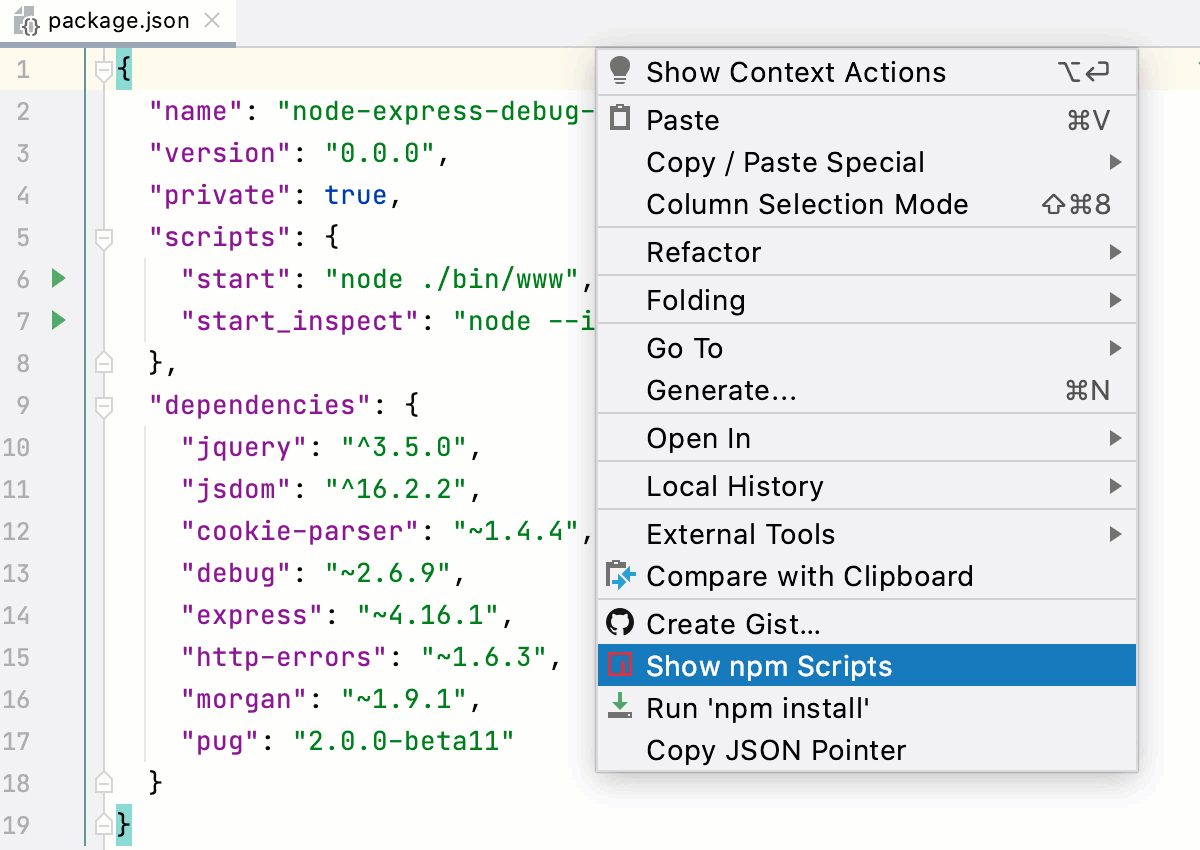- To run npm you should type: npm run dev. So why is NPM important for our project? For example if something happens to our PC (some sort of a crash), we can always recover our project by cloning the project from GitHub (learn how to use GitHub and Git with PHPStorm IDE) and after cloning the project - the package.json file (the resipe of our project) will be inside and after typing in the.
- That works, but it was an annoyance having to search on Google and find this answer. Strange that it's missing, WebStorm should be able to pick up the package.json and show it as an option in the tool window menu. In previous projects I never used the right-click menu and somehow managed to get the npm scripts window showing.
- Npm install saves any specified packages into dependencies by default. Additionally, you can control where and how they get saved with some additional flags:-P, -save-prod: Package will appear in your dependencies.This is the default unless -D or -O are present.-D, -save-dev: Package will appear in your devDependencies.-O, -save-optional: Package will appear in your optionalDependencies.
Phpstorm Npm Update
Skip to end of metadataGo to start of metadataThis tutorial describes how to use the Karma test runner in the WebStorm IDE.
Cerebro plugin to launch PhpStorm Projects. It will find the phpstorm config directory and fetch all the recent project directories. PhpStorm needs to be part of your PATH enviroment variable. If you're using Windows it may be already configurated but on Linux and macOS you have to do it manually.
- Running tests
Karma integration in WebStorm
Starting with WebStorm 7.0, you can use the Karma test runner to run JavaScript tests for your project.
Karma integration in WebStorm:
- Uses local server to run the tests in the selected browsers installed on your computer;
- Allows you to run tests written with the use of Jasmine, QUnit, or Mocha, or to write a simple adapter to use any other framework you like;
- Presents test results and code coverage report by the istanbul code coverage engine right in the IDE.
Installing Karma
First, make sure that Node.js is installed on your computer.
Install Karma usingnpm:
The recommended approach is to install Karma (and all the plugins your project needs) locally in the project's directory.
Use WebStorm’ built-in npm ( Settings | JavaScript | Node.js and NPM) search and install Karma for your project.
Or install it in the current directory using Terminal:
Installkarma-cliglobally:
Use WebStorm’ built-in npm and search for karma-cli, add -g option before hitting Install for global installation.
Or use built-in Terminal to install karma-cli with:
Karma configuration
To run new tests with Karma, you need to have a Karma configuration file (learn more about it).
To generate new configuration file, for example, karma.conf.js in the project directory run in built-in Terminal:
Follow the suggested steps in the configuration dialog.
Note: Most of the framework adapters, reporters, preprocessors and launchers need to be loaded as plugins.
Create a WebStorm Karma Run Configuration:
- Click Create 'karma.conf.js' in the context menu for karma.conf.js file
- Check the paths in the Create Run/Debug Configuration window
- Click OK.
Running tests
Run
A new Karma Configuration will be added to the list of Run/Debug Configurations.
To start running your tests, click Run in the toolbar or in the context menu of Karma configuration file.
Note: WebStorm disables autoWatch in Karma configuration.
You can rerun your tests with the shortcut Alt+Shift+R on Win/Linux or ctrl-cmd-R on Mac.
Click auto-test in the WebStorm Test Run window to enable automatic test rerun: The test will be run 10 seconds after your code was changed, if there are no syntax errors.
Run with coverage

Phpstorm Npm Docker
WebStorm Karma integration allows you to run tests with code coverage provided by the istanbul code coverage engine.
To use Run with coverage feature, a karma-coverage module should be installed via npm.
Make the required changes in the Karma configuration file, for example:
Phpstorm Npm Run Watch
You can navigate through test results in the Run window, check statistics for the tests execution, and make HTML reports from it. Code coverage report will be also available.
